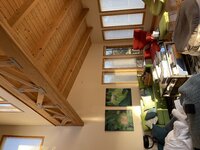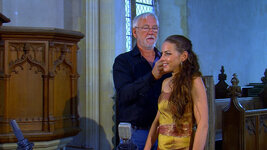I was thinking video for everything, obviously with me hopping back and forth between different ‘scenes’ for singing vs sitting & talking. Would I end up out of sync with video when singing because of the extra process involved?
ribbon questions: passive or active? Near field or far field? I stumbled onto a sample of a younger Wagnerian soprano on a Sandhill ribbon and it sounds pretty good, totally transparent (granted, I’m sure she was in a good space and the 6011 in question is about $1500 over my budget!)
Interesting how close she is to the mic. Her instrument is a shade lighter than mine and has a little more metallic edge on it.
It seems like whenever people try to record me close to a microphone, I end up with an overexposed, too-present sound that sounds horrible to me. At least, compared with recital recordings where there are one or more mics set some distance away and the voice has a chance to bounce around some. And with things like prescreening materials for auditions, you’re of course not allowed to edit anything, so it’s verboten to add room reverb or any other effects.
I had been considering a Royer before, and then my web-scouring also led me to the AEA R84, which is near the upper end for what I would want to spend. And it also turns out Sandhill makes a slightly less expensive ribbon, too (by which I mean more money than I OUGHT to spend, but this is my life and the voice won’t be here forever, so…)
Here are the ribbon candidates:
AEA R84 or R88 (not sure why I would want a stereo ribbon here, would love to hear your opinion)
Sandhill 6019A (rather over what I’d like to spend, but yolo)
Royer R-10
And here are the cardioids that came up:
Beyer M88
Neumann KMS105
Rode NT 1, NT 1A (super economical)
Shure SM7B
Lmk any thoughts. I’ll be doing a coaching in my pianist’s space next week, so at some point in the next couple of weeks I’ll have samples from both spaces. It’d be great to have a solution for recording/streaming at his place — we’ve done audition recordings there, but with the above mentioned foregrounding issue, I wasn’t crazy about any of them. I mean, I hate listening to recordings of myself more than anything, but at least recital and performance recordings don’t make me want to stab myself in the leg with a fork.

Meanwhile, looking around for possible spaces to rent… and learning how the software end works.
And if there are any tutorials you’d recommend for learning about this stuff, please let me know. The extent of my experience has been cutting ends off things in Audacity and playing with Max/MSP …around 12 years ago maybe.
At the software end I’ll probably be using Luna (comes with the Apollo) or Ableton Live.
thanks so much for the help! Let me know if I should send you a check. Or cookies.




